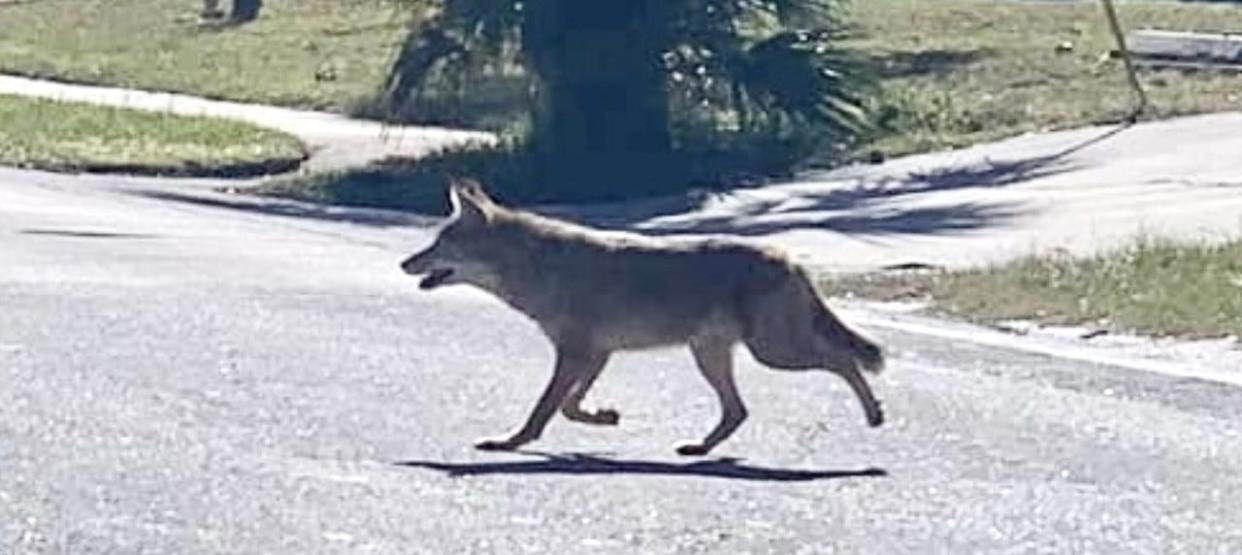Coyotes looking for love pose a danger to your pets: What to do when you see one

Though coyotes are believed to only come out at night, lately they've been showing up during the daytime in residential neighborhoods and pet owners are urged to keep a lookout.
The Florida Fish and Wildlife Conservation Commission describes the coyote as a medium-sized canine, a close relative of the domestic dog, that is extremely adaptable and can be found in rural, suburban, and urban landscapes.
"They are typically shy and elusive but encounters between people and coyotes in Florida are occurring more often," the FWC notes on its website.
Why are they out now?
There is a good reason coyotes have been venturing out more this month. Coyote mating season is from January to March, wildlife officials say.
So, male coyotes are out looking for love. But as they go on the prowl for girlfriends, the mammal, which FWC describes as an opportunistic feeder, will eat your small pets. They may even attack larger dogs, wildlife officials said.
FWC said coyote attacks on humans are rare but they do pose a danger, especially to children.
Where are coyotes found?
According to FWC, coyotes are found throughout Florida, and their presence has been documented in all 67 counties, including Volusia.
A coyote interactive map that FWC uses to track the public's interaction with the animal shows they have been seen all over Volusia County. The map also details the type of encounters or reports made by people who have seen coyotes.
In several incidents in Volusia County animals were killed, according to FWC's interactive map.
Coyote encounters in Volusia County
Coyote encounters In Volusia County are occurring more often, said Robert Hazelwood, a code enforcement officer with the city of Edgewater.
Hazelwood ran into one crossing a street in Edgewater at 1 p.m. in the Falcon Avenue and Mariners Gate neighborhood.
Animal control officers have also responded to several calls about dead cats and dogs reportedly killed by coyotes, he said.
Even if coyotes are not seen, they are around, said Gregory Samano, who had to save his Pomeranian from one in his Wayne Avenue backyard one Sunday morning.
“He maybe thought he’d have a little hors d’oeuvre but I fired two shots at him,” Samano said this week.
Officials discuss coyotesWith coyotes on prowl along coastal Volusia, New Smyrna hosts meeting
Coyotes in Ormond BeachOrmond Beach police urge caution after beachside coyote sightings
What should you do if you see a coyote?
If a coyote approaches too closely, you can frighten it away by hazing, according to FWC.
Hazing is making loud noises and acting aggressively so the coyote leaves the area. Wildlife officials suggest residents may need to increase and continue hazing efforts until the coyote is effectively deterred and leaves the area for good.
How to haze a coyote
Waving your arms in the air and yelling will usually get a coyote to retreat unless there is a den with pups nearby.
Noisemakers are often effective deterrents to coyotes, including air horns, banging pots and pans, and homemade noisemakers.
Throwing small stones or sticks toward (but not at) a coyote will usually cause the animal to leave. Spraying water from a hose or using bear repellent can also be effective hazing methods.
Do not attempt to hurt the coyote because injured animals are more likely to defend themselves; the goal should be to scare the coyote away. Remember that wildlife will attempt to protect themselves or their young if threatened — keep your distance.
Vary your methods of hazing so that the coyote does not become desensitized.
If a coyote approaches a child, an adult should first yell loudly to startle the coyote and then move toward the coyote. This gives the adult an opportunity to lift the child as quickly as possible and back away. Do not run from a coyote, as this may cause the animal to chase.
Teach children to recognize coyotes. If children are approached by a coyote, have them move slowly inside and yell loudly – teach them not to run, approach, or feed coyotes.
5 steps to avoid conflict with coyotes
Never feed coyotes either intentionally or unintentionally.
2. Clean up pet food, fallen fruit, and seed around bird feeders.
3. Secure garbage cans.
4. Close off crawl spaces under porches and sheds to prevent coyotes and other animals from resting or raising their young in areas around your home.
5. Educate your neighbors and ask them to follow these same steps.
This article originally appeared on The Daytona Beach News-Journal: March is coyote mating month

